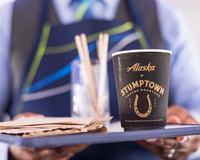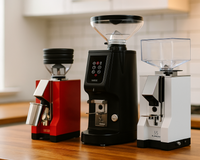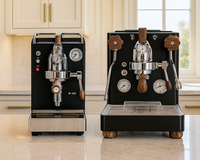Spending over $2,000 on an espresso machine is no small decision. At this price point, you’re entering the world of prosumer espresso gear—machines built not just to impress, but to perform. Whether you're upgrading from a beginner setup or diving straight into the deep end, here's what you should expect—and demand—from a machine in this category.
Don't care for this post? Shop all our espresso machines >
1. Stable, Programmable Temperature Control (PID)
When precision matters, PID controllers are non-negotiable. These systems keep water temperature consistent within a single degree—critical for extracting espresso, especially with light roasts.
Look for: Adjustable PID settings, boiler temperature readouts, and reliable thermal stability during back-to-back shots.
Shop espresso machines with PID >

2. Pressure Profiling or Pre-Infusion Options
Machines above $2,000 should give you some control over how water is delivered to your coffee. This can include soft pre-infusion or full-blown manual pressure profiling.
Look for: Manual paddles, programmable shot profiles, or line pressure pre-infusion. These features help you fine-tune flavor, clarity, and body.
Shop espresso machines with flow control >

3. Dual Boilers or High-Performance Heat Exchange Systems
At this price range, you shouldn’t have to choose between brewing and steaming. Dual boilers give you independent temperature control over each function, while high-end heat exchange (HX) systems are faster and more powerful than their entry-level counterparts.
Look for: Insulated stainless steel or copper boilers, and whether the steam performance meets your milk frothing expectations.
Shop all dual boiler espresso machines >
4. E61 Group Head or Equivalent Commercial-Grade Brewing System
The E61 group head has been an industry standard for a reason—consistent, heat-retaining, and time-tested. Many $2,000+ machines still use it, while others may feature saturated or custom group heads that improve on its legacy.
Look for: Either a traditional E61 or a modern system designed for commercial-style brewing consistency.
Shop all E61 group head espresso machines >

5. Build Quality & Materials That Last
Plastic belongs nowhere near a $2,000 espresso machine. Expect stainless steel bodies, quality fittings, real wood accents, and components built for longevity.
Look for: Solid chassis construction, metal levers/switches, high-quality portafilters, and ergonomic, thoughtful design.
6. Quiet, Powerful Pump System
At this level, you're typically looking at rotary pumps (quieter, plumbable, long-lasting) or high-end vibratory pumps. Both have their place—just know what suits your space.
Look for: Rotary pumps if you're plumbing the machine in or value silence. Vibratory pumps are still solid—just louder and not plumbable.
7. Manufacturer Support and Parts Availability
An elite espresso machine is only as good as the support behind it. You’ll want to ensure the brand is well-established and backed by reputable dealers—like us.
Look for: U.S.-based support, warranty coverage, and easy access to replacement parts and accessories.
8. Aesthetic That Matches Your Space
While performance is key, these machines are also statement pieces. Many now come in modern finishes like matte black, powder-coated white, or even custom wood upgrades.
Look for: A machine you love looking at just as much as using.

Bonus: What You Don’t Need to Overpay For
- App connectivity: Nice, but not necessary.
- Built-in grinders: Best to keep these separate.
- Volumetric dosing (unless you want it): Manual control often yields better results.
Our Takeaway
A $2,000+ espresso machine is an investment in craftsmanship, quality, and coffee as an art form. You’re paying for more than just bells and whistles—you’re buying control, consistency, and longevity.
At Cliff & Pebble, we’ve curated machines that earn their price tag—because we believe every great espresso starts with gear that’s up to the task.















